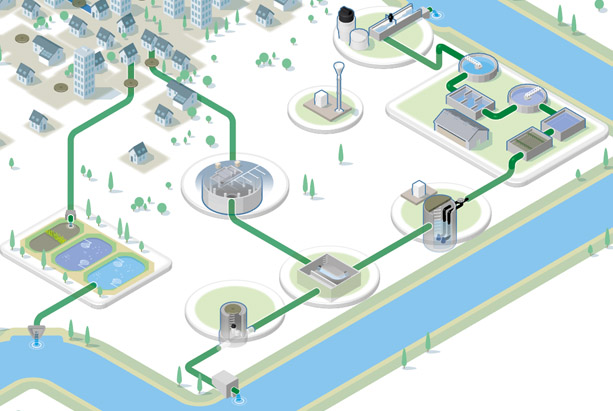Telemetry for managing purification installations and self-monitoring in isolated water service sites
SOFREL’s range of local stations and data loggers are designed to help operators carry out wastewater collection and treatment.

In addition to contributing to the purification process, SOFREL solutions are able to meet regulatory requirements by providing data related to network self-monitoring via their smart archive functions.
Combined sewer overflows (CSOs)/collection systems
Monitoring CSOs and collection systems is particularly tricky (due to floodable installations, power supply and GSM signal reception constraints, etc.). Our SOFREL LT IoT data loggers are particularly well suited to these difficult conditions.
Their unique functions will enable you to monitor and quantify overflows through self-monitoring as well as assist you in performing continuous network diagnostics.

Lifting stations
SOFREL’s local stations enable you to monitor the operation of pumps as well as the volume and flow rates of effluents in lifting stations. Our solutions carry out a series of calculations related to the volume and flow rates in the station and send alerts in the event of overflow or pump malfunction.
Pump management and automation are entirely handled by our equipment which always aims to improve the energy efficiency of the pumps.

Waste water plants
SOFREL solutions for managing wastewater purification plants integrate into the same equipment the native functions for telemetry (e.g. calculations, time-stamped reports on the operation of pumps and motors, alerts about anomalies or malfunctions, etc.) and automation to develop programs for managing travelling screens, sand traps, aerators, recirculation motors, sludge extraction, etc.
Telemetry also enables you to meet the self-monitoring requirements for the plant’s waste.

Rain Gauges
Rain gauge monitoring is used to locally quantify rain intensity and to compare the recorded data with the network’s operation. When the tipping bucket changes position, this closes the circuit. Each pulse is recorded by the SOFREL data logger which continuously archives the rainfall flow rate.
Sending the data to the main stations makes it possible to manage the operation of the wastewater and rainwater network and to detect the presence of infiltration water in the network via night flow rate monitoring.

Water quality and physico-chemical measurements
IP68 and energy self-sufficient data loggers can be deployed at different monitoring and sampling points distributed throughout the network. They manage the physico-chemical sensors (e.g. conductivity, pH, Redox, ORP, etc.) responsible for measuring water quality.
In the event of a threshold overrun, the Data Logger issues an alarm and can control an autonomous sampler to estimate the polluting load.






